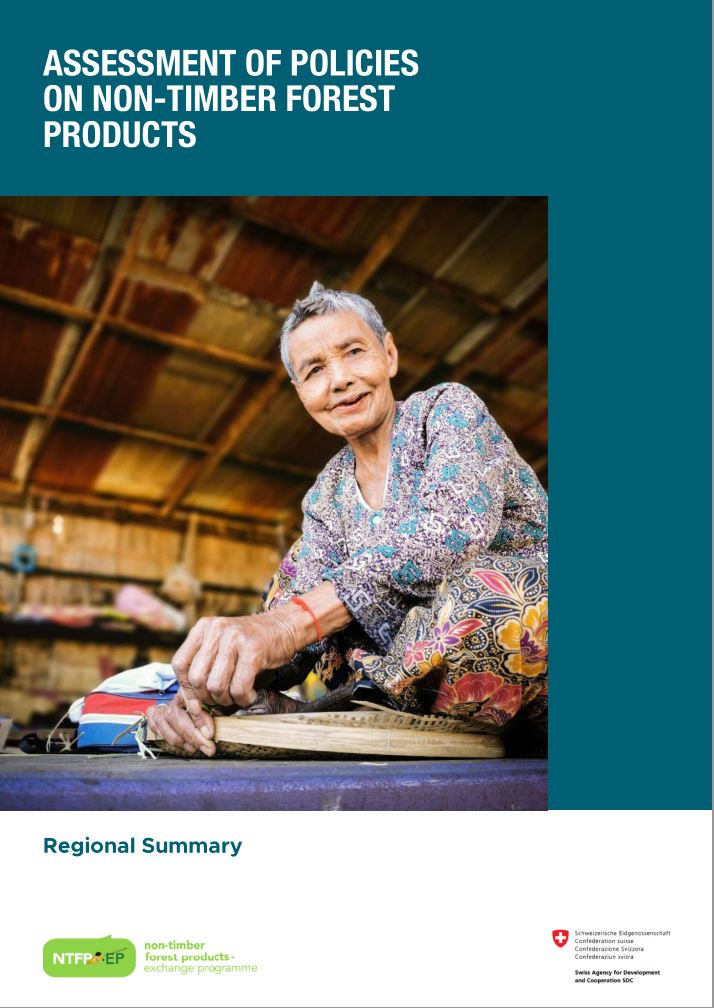Non-Timber Forest Products (NTFPs) policy studies were conducted in four countries: Cambodia, Malaysia, Indonesia, and the Philippines. The policy studies aimed to assess policies on the harvest, utilization, trade, transport, and management of non-timber forest products in Southeast Asia through desk research and analysis of gathered literature and documentation of policies and programs on NTFPs in Southeast Asia.
Definition and classification of NTFPs vary per country. Overall, NTFPs are considered as an important subsector in the forestry sector. However, despite the growing economic importance of NTFPs, it is still not reflected fully in relevant national policies and there is a lack of a specific policy agenda to promote its development, management, and its sustainable utilization. This, in effect, hampers the development of NTFPs as a subsector, particularly on financing and investments.
In the area of community access to NTFPs for harvest, utilization, production, and management, across the four countries, there is a prevailing rule of state ownership of forest resources including NTFPs. However, rules for access and use rights of indigenous communities and local communities are in place. Overall, community access to NTFPs in forest areas are provided and can be deduced from the policies. Despite existing mechanisms (social forestry, Memorandum of agreement, partnerships with concessions etc.), the policies oftentimes only allow for subsistence level of access and will require local communities to apply for permits for commercial or trade purposes.
For NTFP transport and trade, existing regulations for forest products are in place. Generally, local communities may harvest beyond subsistence but require applying for a permit to harvest and transport. The policy framework for business operations for micro, small, and medium enterprises (MSMEs) are also present in all countries. However, accessing the system still pose an enormous challenge for indigenous peoples and local communities and will only be easy if supported by non-government organizations (NGOs) or the government.
In terms of recognition and protection of indigenous knowledge, systems, and practices (IKSPs) on NTFP use and management, the extent of recognition of IKSPs in general and on NTFP harvesting and development greatly varies across the four countries. Philippines have the most responsive policies and Malaysia have the least responsive policies among the four countries.
For value addition and processing, regulation and protection are in place under various laws beyond forestry such as food and drug safety laws, trade laws, access and benefit sharing and intellectual property rights (IPR) to name a few.
Financing for NTFPs mainly comes from government and NGOs. There is an increasing and accessible capital from microfinance that can be availed of by MSMEs, but procedures and tax and non-tax revenues can still be demanding for local communities and disincentivizes community forestry enterprises.
Lastly, on investments and partnerships for NTFP development and MSMEs, there is not much significant investment on NTFPs that emanate from forestry departments, except for Indonesia and some special cases (e.g. bamboo) in the Philippines. Trade and industry sectors have different programs that support businesses such as shared facilities, financial services support, entrepreneurship promotion center, to name a few, and these are common to all the four countries.
In connection to NTFP development, several barriers to development of community forestry enterprises have been identified. These are issues on community access to NTFPs for harvest, utilization, production, management, and trade. The issue emanates from highly regulatory policy frameworks, with clear rules on commercial extraction of timber and access for private business organizations and limited conditions allowing for community access and use rights. Most of the community access rules are designed for traditional and customary use which is limited or interpreted to be only for subsistence. With the access and use rights issues, community forest enterprises are already starting at a disadvantage. In addition, transport documents are often difficult to secure and unnecessarily costly for community groups. They are unable to legally progress to trading and cannot participate in any investment and partnership for NTFP development and MSMEs. Furthermore, there is lack of data on NTFPs in the formal statistics and data collection is limited to very few major NTFPs. Existing policies also have gaps on provisions to improve the capacity of communities to sustainably manage their resources.
Despite these barriers, there are opportunities that can be unpacked for the development of NTFP- based community forestry enterprises. There are movements towards streamlining regulations to facilitate government transactions as well as enable ease of availing technical and financing support for MSMEs in all four countries. There are NTFPs gaining popularity for their medicinal value and due to government programs supporting development of medicine from plants classified as NTFPs. The biggest opportunity for community forestry enterprises is the increasing appreciation towards community-based products, deforestation-free, green, and sustainable commodities, socially conscious manufacturers and customers and increased purchasing power of customers. This market trend is likely to stay and expected to expand more.
From the analyses and findings generated, the paper provides the following key recommendations: (1) Promote and support social forestry schemes anchored in sustainable forest management that integrates sustained contribution in the development of community forestry enterprises; (2) Lobby with the forestry departments and other concerned government agencies to provide clarity on the extent of traditional user rights, customary user rights, and sustainable resource rights; (3) Simplify policies and monitoring protocols to ensure that community forestry enterprises are competitive and well linked to the market; (4) Strengthen the network of agencies, organizations, and people involved and promote NTFPs supported by better data collection and management; and (5) Encourage governments to be aggressive in promoting NTFPs for handicrafts, cosmetics, industrial, and pharmaceuticals uses and to support research and development on NTFPs by communities, scientists, and researchers.





